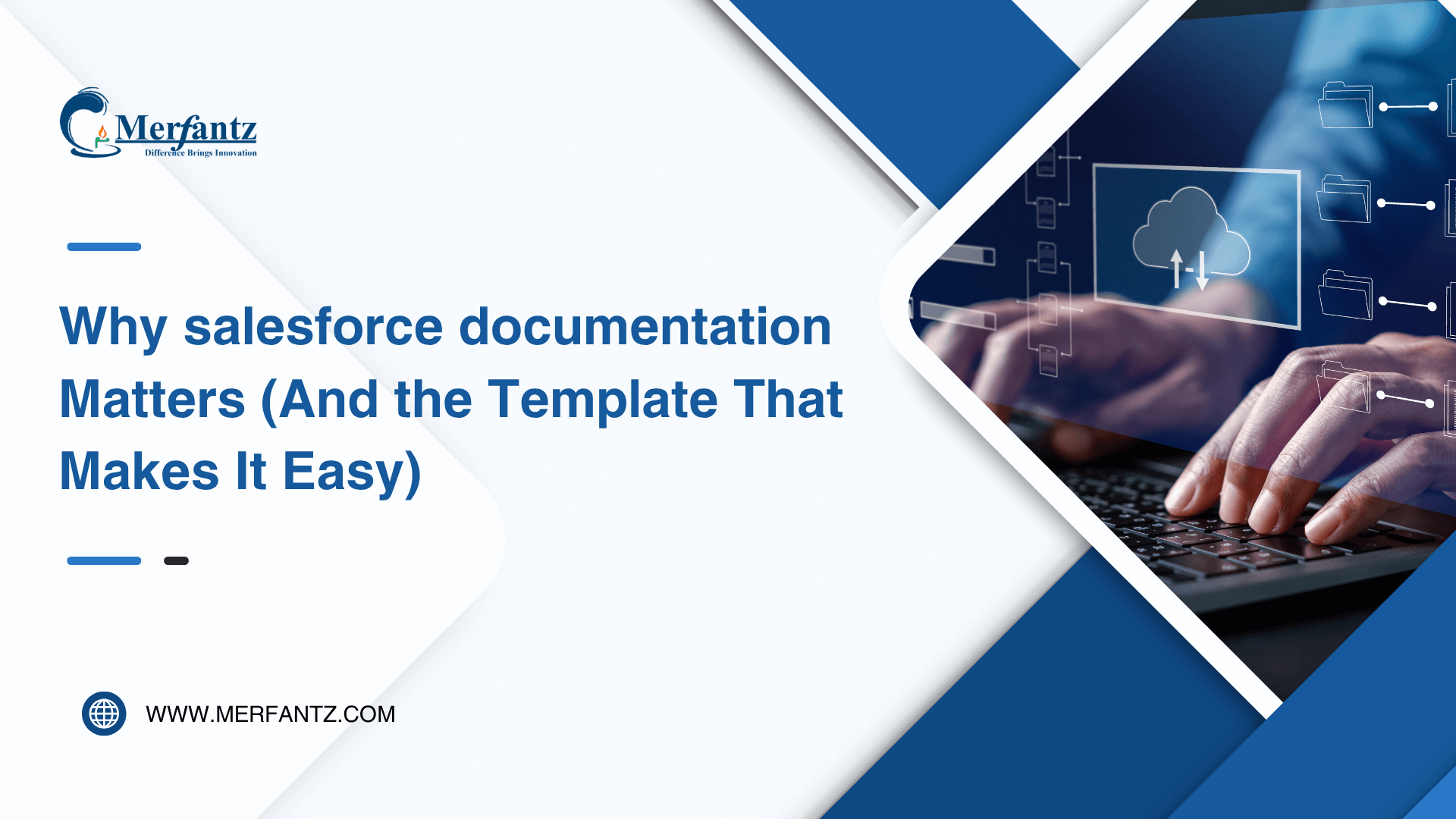
I track a striking fact: teams spend roughly 40% of development time on technical debt, and leaders suggest carving out 10–25% of each release to fix it.
That adds up to lost time, missed changes, and nervous users. I believe clear, living records are the antidote.
In this guide I show my practical method: build a living metadata dictionary, document during real work, and link the How, What, and Why so the org scales with confidence.
Good records speed delivery, lower risk, and let AI drive smarter insights. I follow simple standards—UPN for processes, architecture diagrams, and MDD for metadata—to make both people and machines read my org faster.
I also preview tools and a reusable template that covers intake, scope and impact, resolution details, evidence, and governance cues aligned to best practices.
This is not theory. I use it in daily work to cut rework and make change safer for the business and every user who depends on the platform.
Key Takeaways
- Accurate records reduce rework and speed delivery for the business.
- My three-step method builds durable, living metadata and process maps.
- Standards like UPN, diagrams, and MDD help people and AI read your org.
- A simple template covers intake, impact, resolution, and governance.
- Pilot, timebox, and embed documentation into the build to avoid end-of-project rush.
The stakes right now: why I document my Salesforce org in the age of AI
Today, AI rewards clarity—well-kept records turn guesswork into fast, reliable insight. I treat documentation as the bridge between raw data and useful recommendations.

AI needs two inputs from my org: trustworthy data and clear metadata. Trustworthy data means fields and values are accurate and their population methods are obvious. Metadata means plain-language descriptions that AI can interpret.
Without those inputs I waste time on manual impact analysis and I risk deploying changes blindly. That extra time shows up as rework, angry users, and lost credibility with the business.
Good records speed analysis, reduce risk, and let AI surface smarter, faster solutions.
- I document at the source so every change has context and downstream effects are visible.
- When fields are ambiguous, analytics and AI outputs become unreliable and projects falter.
- Clear descriptions help recommendations follow best-practice frameworks and save time on reviews.
- Documentation is a force multiplier: it cuts future effort and lowers the risk of costly rollbacks.
From chaos to clarity: AI, technical debt, and the real cost of poor documentation
Poor records turn small fixes into multi-day investigations and surprise outages. I see this as wasted time, frustrated users, and stalled projects.
Data is fuel for AI: trusted fields and objects need clear notes about how they’re populated — Flow, Apex, layouts, or integrations. When I record that context, AI can read process maps and propose user stories, acceptance criteria, and test scripts tailored to my org.
Data is fuel for AI: trusted fields, objects, and how they’re populated
I map who writes values and where they flow. That reduces the hours I spend on manual impact analysis and lowers the chance of accidental deletions.
Metadata is fuel for AI: descriptions that drive better recommendations
Labels help, but crisp descriptions let AI recommend solutions aligned to Well-Architected guidance. I fill description fields so suggestions are actionable, not guesswork.
Risk, impact analysis, and the “don’t delete that field” problem
Missing notes hide dependencies. I document relationships so I can see impact before I change anything. This prevents costly rollbacks and downtime.
Agility advantage: faster changes, fewer rollbacks, better adoption
Clear records give me an agility advantage: changes move faster, testing is simpler, and users adopt updates with confidence. I also budget 10–25% of each release for cleanup, steadily cutting technical debt over time.
- I unpack how poor documentation compounds technical debt and costs time.
- I record how fields and objects are populated so AI-driven analysis is reliable.
- I use crisp descriptions to unlock AI-generated user stories and test scripts.
Standards I follow so people and AI can read my org

I set clear standards so team members and AI both read the org the same way. These rules make process maps, architecture diagrams, and metadata useful at every level.
Business processes in UPN: simple, scalable, and AI-readable
I model business processes in UPN with left-to-right flows and one shape per step. I cap diagrams at 8–10 steps and add child diagrams for detail.
This exposes handoffs and where changes will ripple, making impact analysis faster and more reliable.
Diagrams for architecture: a shared language for teams
I document architecture with standard diagrams so admins, developers, and architects speak the same visual language. Consistent layouts cut miscommunication and speed reviews.
MDD for metadata: clear, concise descriptions that reduce ambiguity
I write metadata using MDD principles: explain Why, not What; avoid assumptions; use common TLAs. I version-control diagrams and link specs, test scripts, and notes to keep information connected.
- Better impact analysis and tighter collaboration
- Fewer review cycles and clearer change decisions
- Predictable, auditable updates across the org
Salesforce Documentation
I build living notes so teams spend less time guessing and more time delivering value.
This Ultimate Guide shows who benefits, how to use the method, and where examples sit so you can copy structures into your org quickly.
The promise: what I cover and how to use this guide
I explain the method, share a reusable template, and link standards like UPN, platform diagrams, and MDD to Well-Architected practices.
Use this guide to:
- See who it’s for — admins, developers, and architects looking for a pragmatic approach.
- Navigate the material — start with the method, adopt the template, then add standards and tools.
- Apply examples and field ideas you can copy into your org.
- Expect outcomes: faster analysis, safer changes, and better alignment with the business.
I also show how to document in parallel with active work so you earn quick wins while building lasting habits. The information here supports onboarding and team enablement, and ties each section to measurable delivery and quality improvements.
My three-step method to build durable org documentation
I follow a three-step routine that turns scattered notes into a single, reliable source for every change. This method keeps records current, reduces risk, and proves its value in active work rather than as a separate project.
Build a living metadata dictionary: sync, dependencies, ownership
I maintain a metadata dictionary per org and sandboxes, syncing frequently so it reflects reality. I run dependency analysis and track change history to spot duplicates and potential blast radius before I touch anything.
Ownership and cleanup suggestions live beside each entry. I attach links to specs, tests, and diagrams so the record is actionable at a glance.
Pick a real project: document as you go, not at the end
Rather than launching a broad documentation program, I embed notes into an active project. That captures specifics while they’re fresh and lets me measure the effort against the time saved during impact analysis.
How, What, and Why: link processes to objects, fields, and automation
I map the process (How), link to the metadata I change (What), and record the rationale and evidence (Why). Updating description fields is part of my definition of done so every change carries context forward.
- I include proposed items before build to write descriptions early.
- I track time saved and reduced rollbacks to justify continued use.
- I report externally when cleanup or ownership shifts are needed.
Tooling choices: building inside Salesforce vs. buying a platform
Picking between a built-in app and a change platform is a balance of speed, cost, and scale.
I often start with a custom app when I need fast wins and no extra licensing. A built-in solution can track intake, approvals, time, affected objects, and tools used. I leverage Lightning pages, Field-Level Security, paths, Tasks, Topics, Notes, and Slack screen flows to keep stakeholders informed.
Build it in the platform: lightweight apps and tight control
Advantage: no extra licensing and high flexibility for small to mid-size orgs. I expose only the fields stakeholders need via profiles and FLS. For lightweight project structure I add PMT Projects from Salesforce Labs.
Buy a Change Intelligence Platform: scale and proactive insight
A change platform provides synced metadata dictionaries, multi-level impact analysis, notifications, reporting, and AI-readiness at scale. Buyers often budget up to 5% of their platform spend for this capability.
- I build a custom app when my implementation needs speed, flexibility, and minimal cost.
- I choose a change platform when deep impact analysis, multi-org scale, and proactive notifications matter more than maintenance effort.
- I align the choice to my teams’ maturity, governance needs, and the expected volume of changes across the business.
The template I use to document changes and context
I build each change record to be searchable, actionable, and auditable from intake to release. The template captures essential facts up front so teams can triage and filter requests quickly.
Intake essentials
I record subject, requester, desired timeline, and whether the work is a feature or a bug fix. I add the business need and a concise problem statement to preserve context and avoid repeating questions later.
Scope and impact
I list the objects touched, and I name each field changed. I map the processes involved and note related apps when the change crosses systems.
Resolution details
I specify the chosen solution approach, tools used (Flow, validation rules, etc.), time spent, and the owner. This makes future estimation and planning more accurate.
Linkage and evidence
I attach process maps, user stories with acceptance criteria, test scripts, and release notes. I keep notes for rationale and meeting outcomes and add links to related work so the full chain is traceable.
Governance cues
I record priority, approvals, and Well-Architected considerations so decisions are visible and defensible. Consistent categories (feature or bug) feed analytics and improve forecasting.
- I start entries with subject, requester, and timeline to enable quick filtering in list views.
- I keep a short problem statement to preserve context and reduce repeated questions.
- I attach evidence and links so reviewers see the full solution and test coverage at a glance.
Implementation playbook: how I roll this out with my teams
My launch begins small: a timeboxed pilot to validate standards and measure impact. I define clear Description standards (MDD) up front so everyone writes the same short, useful notes.
Pilot first: timebox analysis, define Description standards, iterate
I run a short pilot on one project and set a strict timebox for analysis. That forces practical choices and shows real-world time to document tasks.
I collect feedback from stakeholders and my team, then iterate the standards before wider rollout. Pilot analytics are visible so leaders see early value.
Bake-in documentation: add links and descriptions during build
I require description updates and links as part of the definition of done. This reduces omission and makes impact reviews faster.
Automation handles repetitive steps where possible, and I add documentation tasks to deployment checklists so nothing is skipped.
- I train teams on UPN, diagrams, and the template so output is consistent across workstreams.
- I measure time spent versus time saved on impact analysis and rework to prove ROI.
- I socialize pilot wins—fewer rollbacks and cleaner handoffs—to expand adoption across the business.
Measure what matters: analytics that prove the ROI of documentation
I measure the success of my records with hard metrics, not opinions. I track a tight set of delivery, investment, and adoption signals so the team sees real returns.
Delivery metrics
I monitor throughput, lead time, change failure rate, and rollbacks to assess delivery. These numbers show velocity and stability at the project level.
Investment metrics
I compare time spent on impact analysis upfront versus time lost to rework and firefighting. That comparison quantifies the net gains from investing in better documentation.
Adoption and quality
I measure user feedback, test coverage, and description completeness. Higher engagement and fuller metadata correlate with fewer production issues and faster releases.
- Delivery: throughput, lead time, failure rate, rollbacks.
- Investment: time on impact analysis vs. rework and firefighting.
- Adoption: user feedback trends, test coverage, description completeness.
- Segmentation: metrics by project and change type to find where documentation has most impact.
- Leading signals: stakeholder engagement with diagrams and linked information predicts better outcomes.
I present these figures in dashboards and answer the questions that matter: are we shipping faster, breaking less, and supporting the business better? I then tie specific improvements—like linking processes to metadata or enforcing short descriptions—to observed reductions in rollbacks and time lost to firefighting.
Conclusion
Clear change records make impact analysis fast and let teams act with confidence.
I reaffirm the core message: strong salesforce documentation is the foundation for safer changes, faster delivery, and AI-readiness on the platform. My approach is simple—standards first, a living metadata dictionary, document-in-flight on a project, and connect How, What, and Why for lasting clarity.
Choose a practical solution: build inside the org for speed or adopt a Change Intelligence solution when scale matters. Consistent architecture and process structure align people and systems and cut review cycles.
Start small this week: pick one project, apply the template, measure time saved and rework avoided, and share feedback or questions so the guide evolves with your business.
FAQ
Why does documenting my org matter now, especially with AI in play?
What are the biggest risks if I skip proper documentation?
How do I make metadata useful for both people and AI?
What standards should I enforce so documentation stays readable and actionable?
How do I document changes during a real project without slowing delivery?
What does a minimal but complete change template include?
Should I build documentation inside my org or buy a platform?
How do I measure the ROI of documentation?
How can I reduce the “don’t delete that field” problem?
What tooling features matter most for long-term documentation success?
How do I get teams to adopt documentation practices?
What’s the best way to keep a metadata dictionary “living”?
How do diagrams and architecture notes help non-technical stakeholders?
What’s a practical first step for teams that have no documentation at all?
How do I balance brevity with enough context in descriptions?
How often should I review and update documentation?
Can good documentation reduce automation failures?
What role does governance play in documentation quality?
How do I surface documentation gaps to teams without blaming individuals?
Author Bio
Co-Founder & CMO at Merfantz Technologies Pvt Ltd | Marketing Manager for FieldAx Field Service Software | Salesforce All-Star Ranger and Community Contributor | Salesforce Content Creation for Knowledge Sharing





